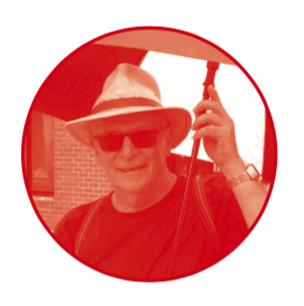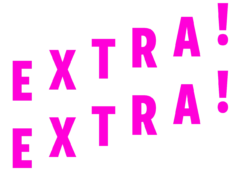by Chris Nash

Chris Nash was Professor of Journalism at Monash University, and previously Director of the Australian Centre for Independent Journalism at UTS.
When Guggenheim Director Thomas Messer cancelled Hans Haacke’s commissioned exhibition in May 1971 because it was “not art but journalism”, the supporters of Haacke and sacked curator Edward Fry bypassed the journalism question to support the artistic merit of the works. Messer’s description of the work as “muckraking” invokes the North American term for investigative journalism linked with moral outrage going back to the nineteenth century. Subsequently Grace Glueck, the New York Times (NYT) arts reporter who covered the Haacke controversy for her paper, recalled how she had
marvelled at his diligence and skill as an investigative reporter. Had Haacke not devoted himself to art, he might have become an exemplary journalist, not only because of his bulldog talent for research, but also because of his total indifference to the power wielded by important people who are anxious to keep publicly questionable activities private. His work is all the more convincing because, while it comes out of a deep passion for justice, its presentation is studiedly dispassionate.
Glueck also attributed to Haacke the “fourth estate” ethical commitment of journalism to the public interest, and linked it to the calibre of his research, which included both documentary and human sources of journalists.
Haacke’s success as a watchdog of public morality is due in no small measure to his prodigious research efforts. While many artists need go no further than their own studio for their material, he travels far and wide, visiting libraries, checking archives, reading obscure publications, examining court documents, talking with “sources”. And he keeps extensive files on his targets.
Glueck’s view is that because of the high calibre of his research and his concern with issues involving public morality, Haacke’s art substantively is journalism – with the converse implication that as journalism it is also art.
This was precisely Messer’s problem with the work. He specified the verifiability and meaning of the facts being reported by Haacke as a basis for rejecting the works. If Haacke had been merely appropriating some unusual object, medium or process to make a symbolic statement, much as Duchamp did with his urinal, wine rack and snow shovel, then there would have been no problem, but because Haacke’s art was making statements about facts open to verification in the material and social worlds, it was unacceptable to Messer.
Haacke himself has never rejected the art-journalism linkage, although he has never identified himself as anything other than an artist. He had quickly realised the significance of Messer’s hostility on the verifiability issue for what it revealed about the importance of methodology in the politics of art and knowledge. Thereafter he used the research methodologies of journalism as a staple of his practice.
Apart from Glueck at the NYT, other journalists over the years who reported and analysed the controversies generated by Haacke’s artworks also recognised both the reliability of his factual evidence and his journalistic sensitivity for the “productive provocations” that would provide access into institutional politics – his news sense. For most of the other institutions that exhibited these and similar artworks by Haacke, the works maybe were or were not journalism, but either way it didn’t seem to matter. For those institutions for whom it did matter – the Wallraf-Richartz-Museum in Kassel with Manet PROJEKT ’74 in 1974 and Köln’s Westkunst exhibition with Der Pralinenmeister (The Chocolate Master) in 1981, not to mention the institutions that discreetly avoided commissioning work from Haacke – the problematic issue was the same one: his claims to verifiable truth about the sensitive activities of people or organisations involved with the museum.
The very scale and intensity of the conflict at the Guggenheim in 1971 suggests that there was something deep and serious at stake in the journalism-art connection. The conflict was reported in detail in the New York Times, and their art critic Hilton Kramer was an assertive combatant in the struggle. Curator Edward Fry, an internationally respected expert on modern art, was dismissed for supporting Haacke and never worked again in a US art institution [see EXTRA!EXTRA! edition 3 for more on this story]. It took almost four decades before Haacke’s work would be purchased by a major US institution: Shapolsky by the Whitney Museum of American Art in 2007, in a half-share with the Museum of Contemporary Art in Barcelona. In the meantime Haacke’s star had risen high in the international art firmament and, as Buchloh observed in a detailed analysis in 1988, his continuing marginalisation by elite US and German public institutions was meaningful in itself and required analysis. A reunified Germany acted with the 1991 Venice Biennale invitation for GERMANIA and the contested Bundestag invitation of 1999. In US art circles, the situation was undoubtedly an embarrassment when the Whitney finally acted in 2007 to purchase Shapolsky as one of the major works of 1970s American art. Nonetheless, four decades of prolonged absence demands an explanation.
In passing, the ignorance about this conflict among scholars of journalism is also important and needs to be rectified. In parallel to the art world, that ignorance is indicative of, in Buchloh’s terms, a failure to recognise “a turning point – one of those historical moments in which a set of traditional assumptions about the structures and functions of art are being challenged.” Haacke’s work, precisely because it brings journalism and art together as methodology, highlights the issue and can bring journalism into focus with contemporary art practice and theory.
Haacke proposed a relational approach to the issue of what is art, asserting the inherent social and political nature of the question:
Products that are considered “works of art” have been singled out as culturally significant objects by those who, at any given time and social stratum, wield the power to confer the predicate “work of art” onto them; they cannot elevate themselves from the host of man-made objects simply on the basis of some inherent qualities. Today museums and comparable art institutions … belong to that group of agents in a society who have a sizable, though not an exclusive share in this cultural power on the level of so-called “high art”. Irrespective of the “avant-garde” or “conservative”, “rightist” or “leftist” stance a museum might take, it is among other things a carrier of socio-political connotations. By the very structure of its existence, it is a political institution. This is as true for museums in Moscow or Peking as it is for a museum in Cologne or the Guggenheim Museum.*
From Haacke’s definition, an artist cannot but be involved in the politics of art, even if only passively as the beneficiary and bearer of a conventional wisdom about the nature of art. Similarly, a journalist cannot but be involved in the politics of knowledge, even if only passively as the beneficiary and bearer of a conventional wisdom about the nature of news.
* Excerpt from “All the art that’s fit to show”, in Hans Haacke: For real: Works 1959–2006, eds. Matthias Flügge and Robert Fleck, Richter Verlag, Düsseldorf, 2006.
This is an edited extract from What is Journalism? The Art and Politics of a Rupture published by Palgrave Macmillan, 2016. For further information contact chris@chrisnash.com.au
